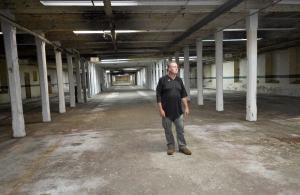
08 May 2016 Sibley Mill Envisioned as a Tech Citadel for Augusta
One of the more subtle architectural flourishes at Sibley Mill is the Latin inscription on each of its wings: Esse quam videri.
The expression on the Sibley family crests adorning the four-story building means “To be, rather than to seem.” The phrase was especially poignant when this hulking industrial cathedral was erected along the Augusta Canal during the South’s transition to a mechanized economy 136 years ago.
But today, a decade after the textile mill’s machines fell silent, the cast-iron inscription takes on a different meaning as two South African-born entrepreneurs and the building’s owner attempt to redevelop the 19th century factory into a 21st century high-tech business park called “Augusta Cyber Works.”
Last week, the parties announced an ambitious proposal to build a 10-megawatt data center on the 20-acre Augusta Canal Authority-owned property to meet the growing data needs of the city’s burgeoning cyber industry and act as a magnet for other tech companies.
The novel aspect of the estimated $90 million to $150 million development – besides being housed in more than 500,000 square feet of neo-gothic factory space – is that the massive stack of servers would be both powered and cooled by the flowing waters of the Augusta Canal.
THE PROJECT’S brainchild is James Ainslie, the CEO of Cape Augusta Digital Properties, who has developed data centers in his native South Africa and was previously head of Johannesburg-based Cloudseed.
He and business partner Wayne Millar, a fellow countryman and real estate developer who has lived in the Augusta area for more than a decade, envision the Augusta Cyber Works campus as a sort of high-tech citadel in the heart of the city.
“No community can function without a flag, a bastion, a fortress – and we hope that this building and this site becomes a fundamental component to the cyber initiative in Augusta,” he said at Wednesday’s news conference announcing Cape Augusta’s 75-year lease on a facility that has sat idle since Avondale Mills shuttered its denim operation in 2006.
The canal authority acquired the real estate from Avondale in 2010 and embarked on a massive environmental cleanup with the hope of seeing it renovated in a manner similar to Enterprise Mill, the complex a mile downstream that Augusta businessman Clay Boardman turned into an upscale mixed-use development nearly two decades ago.
Canal Authority Executive Director Dayton Sherrouse said his board considered several proposals before
going all in on the data center concept 18 months ago.
“These ranged from creating a college campus annex to housing a hydroponic fish farm – and everything in between,” he said.
The proposal by Ainslie and Millar appeared to make the most economic sense. And with Fort Gordon undergoing a massive buildup from its new cyberdefense missions and defense contractors streaming into the Augusta market, the timing seemed right. The authority’s board approved the long-term lease April 25.
DATA CENTERS, also called “server farms,” are considered the backbone of the new economy, providing the infrastructure corporations and governments need to run their computers. The industry has grown as consumers increasingly use “cloud”-based services offered by web giants such as Amazon, Facebook and Netflix.
The market for independent data centers grew 6 percent last year to $115 billion, according to Chicago-based real estate investment firm Jones Lang LaSalle.
New York-based tech consulting firm 451 Research says the Southeast – and metro Atlanta in particular – is attractive for data centers because of the low risk of hurricanes and other weather-
related disruptions, and because construction and operating costs are lower than other parts of the country.
Those same benefits can be found in Augusta, 451 Research’s Andrew Donoghue said.
“Power is inexpensive compared with national averages and has proven to be extremely stable and reliable,” he said.
Data centers consume massive amounts of electricity, and few have the benefit of their own source of “green” energy like the proposed Augusta Cyber Works. The three hydroelectric turbines installed at Sibley Mill in the 1940’s produce about 1.7 megawatts under normal operations. That’s roughly 17 million kilowatt hours per month; the average U.S. home consumes about 1,000 kilowatt hours per month.
On the open market, that energy would be worth more than $1,000 a day. For a future Augusta Cyber Works tenant, it’s a major incentive.
Walter Sprouse, the executive director of the Augusta Economic Development Authority, the organization charged with recruiting new business and industry to Richmond County, pitched the concept to site-selection consultants during a recent trip to Chicago.
“Their eyes lit up when we told them about the hydroelectric on site,” he said.
Of the 15 firms he contacted about Sibley Mill, 13 returned his calls – a pretty good ratio in the industrial recruiting business.
The 600 million gallons spinning the turbines each day also would provide a way to keep the monstrous racks of servers and computer equipment from overheating. The average water temperature is 65 degrees and largely debris-free when it gets to the mill’s pipes.
“If you set (canal water) up beside a glass of city water, you couldn’t tell a difference,” said Billy Power, the authority’s maintenance supervisor, who worked at the mill when it was owned by Avondale and, before that, the Graniteville Co.
The first owner was the mill’s developer, Josiah Sibley, a cotton broker and civic leader who built his venture on the site of the Confederate Powderworks factory, which supplied the South’s munitions during the Civil War. About half a million bricks from the powderworks were used to build the mill, but the only powderworks structure still standing is the obelisk-shaped smokestack fronting the canal, built in 1845.
Cape Augusta and the canal authority say the mill property’s historic significance – it’s on the National Register of Historic Places by virtue of being in the Augusta Canal National Historic Landmark District – make it eligible for preservation-based tax credits that should help offset the redevelopment project’s cost.
IN ADDITION TO venture capital funds, Ainslie and Millar say they intend to seed the multi-phase project with up to $20 million in financing through the New Market Tax Credit program – a $3.5 billion Treasury Department initiative that funds economic development projects in low-income areas. To incubate the project further, the 75-year lease agreement postpones rent payments for the first five years.
The canal authority also owns the adjacent King Mill, which is occupied by Standard Textile. It has granted Cape Augusta the rights to expand to that 600,000-square-foot property as Standard’s operation comes to a close.
Cape Augusta expects to sublease portions of the redeveloped mill and surrounding campus to “technology companies, data center users and operators, integrators and cyber-educators.” Ainslie said the company plans to announce its first tenant later this month at an event that will double as a groundbreaking ceremony for phase one of the project.
Earlier this year, Cape Augusta filed site plans to renovate more than 36,000 square feet into office space. Ainslie said the yet-to-be-disclosed commercial tenant could move in by November.
The proximity to Augusta University’s downtown campus would make the mill property a logical place to place its growing cybersecurity and computer science programs. AU President Brooks Keel has stated his interest in what he calls the “cyber village” concept, but there are no formal agreements between the developers and the university.
Still, the Augusta Cyber Works backers envision the mill campus becoming a mini version of Maryland’s National Business Park, a sprawling office complex in Baltimore across from National Security Agency headquarters and just down the road from Fort Meade – the base Fort Gordon is siphoning most cyber-related military jobs from.
The mill brought prosperity to the region nearly a century and a half ago, and they reckon it could do so again if their plan is successful.
“Augusta is again on the cusp of another economic revolution,” Sherrouse said.
Source: The Augusta Chronicle
Author: Damon Cline/Business Editor

